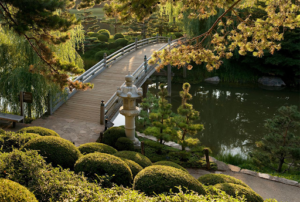Professor VanOpstal Rediscovers an Island
8/17/18
“One of the great things about growing up is getting to inflict things from your childhood on your kids. They’re still young enough to be excited about it, fortunately. This summer, it was an island I’d grown up visiting from time to time. Islands are always worthwhile, but this one had a little mystery to it.
Before we got there, I told them about it: this island, or a part of it, is invisible. You can only see it if you’re very still. Predictably, my boys proved to be suspicious initiates into the mysteries of the island. When we came to a great wooden bridge, carved in the ornate Japanese style, one of them peered around it and said, “But I can see the island already!”
“When you cross the bridge onto the island,” I said, doubling down, “if you aren’t very still, there’s an island there you’ll never see.” Success was questionable, but they were willing to give me the benefit of the doubt. They tramped cautiously onto the bridge with the sad subtlety of Elmer Fudd on a bunny hunt.
The morning sun had lifted the fog hovering on the water. The bridge arched gently to reveal the island rising from the lake as we crested the midpoint, and a winding gravel path strayed from the bridge into a carefully cultivated Japanese garden. Beds of slow-creeping vines and sedum swept around large rocks burgeoning gently from the earth, and fine, green grass sloped down to the water’s edge. Pine trees, large and small, were trimmed judiciously in the Japanese style, perched like gigantic bonsai along the path. In the soft light, birds swooped from tree to tree and chipmunks darted cheekily across the footpath, hoarding their precious treasures. My boys threw caution to the wind to take dominion of this mysterious island.
If it hadn’t obviously belonged to a gardener who cared for it extremely well, we would’ve been tempted to find the biggest rock we could and claim possession of the island for ourselves. But it had a gardener, and a very attentive one. (He had mastered, for those who care to know, the art of niwaki, or aesthetic pruning). Over weeks, months, and years, the gardener had patiently clipped a branch here and a twig there, having always in mind the nature of each tree and shrub. Patiently, respectfully, he had tried to reveal the character of each one. That revelation depended, of course, on having eyes to see.
The secret of the island was that it showed both the appearances of things and their essences, when you stopped to look. The path was laid down so that we came to regular resting places along the way, and each interval opened into a panoramic view that revealed a balanced and harmonious composition, a living work of art. With his pruning shears and ample patience, this gardener had respectfully revealed the nature of each thing, and had opened a window into the mind of God in creation. This island was really two islands, and not everyone had the eyes to see both.
On this particular adventure, my boys saw many very beautiful things, and began to learn that there was more to see. That, I’m glad to say, is a wonderful beginning.”
